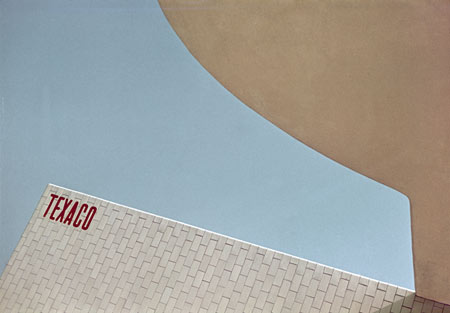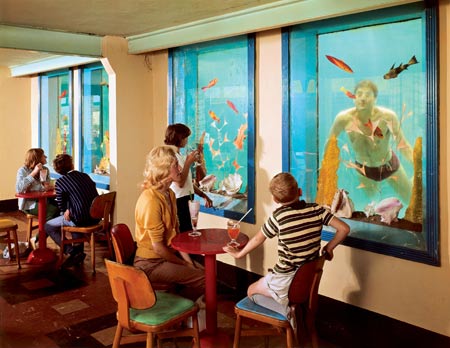A conversation with Martin Parr
Apart from being an accomplished photographer, Martin Parr has been active as a book editor (for example, Boring Postcards or The Photobook: A History
) and curator. This Summer, “Colour before colour - 1970’s European Color Photography” will be on view at Hasted Hunt gallery, curated by Martin and showcasing six not very widely known early European colour pioneers. I talked to him about the show.
Jörg Colberg: Why did it take so long for colour photography to be accepted as an art form?
Martin Parr: I guess because the museum/art world was rather dismissive of it. Although, as soon as colour was invented it was used used for commercial purposes, and there were indeed some photographers who did their own work in it. It wasn’t ever taken seriously. If you did serious photography, it had to be done in black and white. Colour was regarded as rather commercial or as “something from the album”.
 (Keld Helmer-Petersen)
(Keld Helmer-Petersen)
JC: And then it was John Szarkowski who broke it into the art world.
MP: He was part of the machinery in the 1970s or the institutions in the 1970s. There was a change in perception because of the famous Eggleston show.
 (Peter Mitchell)
(Peter Mitchell)
JC: What I’m curious about is why did Europe mostly miss out, at least in the early stages of getting colour photography into museums?
MP: The whole point of this exhibition is to demonstrate that there was intelligent colour photography being viewed in Europe, but because we didn’t have the powerful art institutions behind the photographers, or there weren’t the exhibitions that became the landmark pointers, they weren’t particularly known. So the purpose of this show is to just really say “Yes, we all know about the 70s in America when colour became accepted part of the contemporary practice, but did you know it happened in Europe as well?” We show photographs from different photographers, starting with Keld Helmer-Petersen, who did probably the first intelligent colour photography book in 1947.
 (Ed van der Elsken)
(Ed van der Elsken)
JC: I discovered one of the photographers, Dutch photographer Ed van der Elsken, just last year when I in Holland. I as really surprised because at first I thought “Wow, this is great!”, and I couldn’t really find anything online, apart from some few samples. I thought that those were very interesting if you compare them with what people in America were doing. So if you compare these European colour photo pioneers with their well-known American counterparts what similarities and differences do you see in what they were doing?
MP: Van der Elsken was a maverick photojournalist or documentary photographer, and he did colour and black and white. His most famous book was done in black and white. But he also did colour. He did it without really thinking. It wasn’t a big issue. He just did it, because colour was there.
Most of the photographers in America had started out in black and white, even Egglesteon, even Shore, and they all moved to colour, as a conscious statement: “Why shouldn’t we shoot this in colour?” It is almost political, whereas Van der Elsken was highly intuitive.
The one that has most similarity to the mentality that happened in America and that you’re more knowleable with because its history is quite well known is Luigi Ghirri, who has most overlap with that sensibility from the American colour photography of the 70s. I’ve never seen a black and white picture of his. I think he was really an early colourist. He was doing colour pictures in the late 50s, rather than moving from black and white to colour. Even Eggleston moved from black and white to colour in the early part of his career.
 (John Hinde)
(John Hinde)
JC: You might know I have a blog where I link to photography. I’d be interested to find out how, apart from going to your show at Hasted Hunt, what’s a good other way to see the works of those early European pioneers? Are there any books available? Are there websites?
MP: There are books, and they’re very obscure. It’s unlikely that any American book shop would have any of them. It’s as simple as that. Aperture are finally doing a book about Ghirri next year. Helmer-Petersen’s book “122 Colour Photographs” was published in 1947 and is out of print, of course. You can get Van der Elsken’s books; “Hello”, for example, is in colour, but they’re not particularly his best colour pictures. No one has even heard of Carlos Siquier in America, let alone knows he has a book. There’s one book by Peter Mitchell, which has some black and white and some colour, but he never did a book with his earlier body of work. John Hinde has a book out, in fact the one that I edited, (Our True Intent Is All For Your Delight).
So these people are written out of history. The history of photography is so subjective, and the more we go on, the more we realize how subjective it is. I think this is another interesting example of how things are being overlooked, because nobody knew about them. Either people didn’t know about them, or they were just too lazy or lacking of interest to include them.
 (Luigi Ghirri)
(Luigi Ghirri)
JC: I’m sure lots of people will be surprised to actually see that photography and to realize that there were people in Europe doing this. And I think that’s why the show will be immensely valuable. I certainly hope that maybe some of these books will be re-printed so that the photographs will become more widely available.
MP: Yes. Ideally, there eventually would be a catalogue along these themes and ideas, but there’s nothing at the moment and the time. Nothing yet.
JC: Do you have any plans on getting the show to different places, or is it just that one show?
MP: I do have interest from a dealer in California, but other than that not really. It could eventually become a museum show. The great thing with a commercial gallery is that you can have an idea and do it in six months; you have a museum show and then you might do it in five years’ time if you get the money. That doesn’t sound very exciting to me. And remember, the institutions in America are often very slow at responding to things.
 (Carlos Perez Siquier)
(Carlos Perez Siquier)
JC: But then of course’s there’s a little bit of a European aspect to it, too, because lots of people in Europe don’t know the whole story, either. Are there any shows being planned in Europe?
MP: Not yet. Some of these photographers I have shown individually, but never as a group. With Hinde and and Helmer-Petersen, I’ve been a party to people’s reawakened interest. I’ve known about people like Siquier for years, but even in Europe I’d say he’s pretty obscure. In Spain they know him, because he is Spanish, but outside of Spain, people wouldn’t.
This conversation was commissioned by American Photo and can also be found here. All photos courtesy of Hasted Hunt gallery.
 By
By